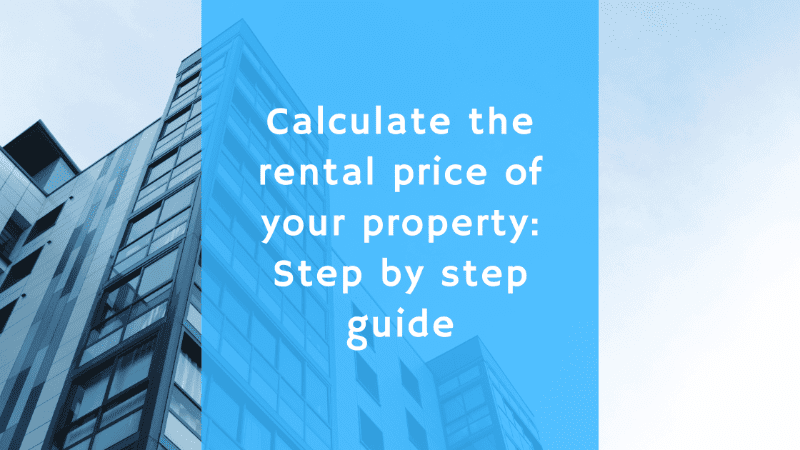Knowing how to calculate your rental rate is not about picking a number others are charging and charging a similar rate. You’ll also need to consider the home’s location, value, amenities, condition, and safety for your tenants.
Tenants have so many choices when it comes to rental properties, so you have to make yours stand out. This means setting the right rental price that attracts high-quality tenants and reflects the positive attributes of your property.

Reasons why it is important to determine the rental price
Determining the right rental rate for your property is of paramount importance for several reasons:
- Maximizing Rental Income: Setting an appropriate rental rate allows you to maximize your rental income. Charging too little may result in lost potential revenue, while charging too much can deter potential tenants.
- Attracting Quality Tenants: A well-calculated rental rate can attract quality tenants who are willing and able to pay the rent consistently and on time.
- Reducing Vacancy Periods: An accurately priced rental property is more likely to be occupied promptly, reducing vacancy periods. Vacancies can be costly as they result in zero rental income and may require additional expenses for property maintenance and advertising.
- Covering Operating Expenses: The right rental rate should cover your property’s operating expenses, including property taxes, insurance, maintenance, and property management fees. It ensures that your investment remains financially sustainable.
- Maintaining Competitiveness: By keeping your rental rate in line with the local market, you can remain competitive. Tenants typically compare rental prices when searching for properties, and if your rate is too high compared to similar properties, you may struggle to attract tenants.
- Compliance with Regulations: In some regions, there may be rent control laws or regulations that limit how much you can increase rent each year. Knowing the appropriate rate can help you stay compliant with these regulations and avoid legal issues.
- Tenant Retention: Setting a reasonable rental rate can contribute to tenant satisfaction and increase the likelihood of tenant retention. Happy tenants are more likely to renew their leases, reducing turnover costs and ensuring a steady rental income stream.
- Property Valuation: Rental income is a key factor in determining the overall value of your property. An accurately priced rental property can potentially increase the property’s appraised value, which can be advantageous for refinancing or future sales.

Guide to determining the rental price of your property
Whether you’re a first-time landlord ready to test out the rental market or a more experienced landlord trying new locations and property types, this step-by-step guide will help you calculate the ideal rental rate for your property:
- Research the Local Market Before setting a rental rate, it’s essential to understand the local rental market. Conduct thorough research to determine the average rental rates for properties similar to yours in the same neighborhood. Online real estate listings, property management websites, and even speaking to local real estate agents can provide valuable insights.
- Evaluate Your Property’s Features Assess your property’s unique features and amenities. Consider factors such as square footage, the number of bedrooms and bathrooms, the condition of the property, and any special features like a garage, outdoor space, or modern appliances. Properties with more amenities and in better condition can command higher rents.
- Calculate Operating Expenses As explained before, to ensure your rental income covers expenses and provides a profit, you need to calculate your property’s operating expenses (property taxes, insurance, maintenance costs, property management fees…).
- Determine Your Desired ROI Decide on the return on investment (ROI) you want to achieve with your rental property. Typically, investors aim for a ROI of around 6-10% or more. Calculate the ROI by dividing your annual rental income by your property’s total value (purchase price and renovation costs).
- Account for Vacancy and Turnover Expect that your property may not always be occupied, so it’s wise to account for vacancy periods in your rental rate calculation. Many landlords include a vacancy rate of around 5-10% in their calculations. Additionally, factor in the costs associated with tenant turnover, such as cleaning, painting, and advertising for new tenants.
- Use Rental Rate Calculation Tools Several online tools and rental rate calculators are available to help you determine a competitive rental rate for your property. These tools often consider local market data, property details, and other variables to provide an estimated rental rate.
- Adjust Based on Demand Keep an eye on the demand for rental properties in your area. If you’re struggling to find tenants at your initial rental rate, you may need to adjust it downward to remain competitive. Conversely, if there’s high demand, you could consider increasing the rent.
- Legal Considerations Be aware of any local rent control laws or regulations that may affect your ability to set rental rates. Some areas have restrictions on how much you can increase rent each year.
Calculating the rental rate for your property is a critical step in successful property management.
By researching the local market, evaluating your property’s features, accounting for expenses, and considering ROI, you can arrive at a fair and competitive rental rate.
Remember to stay flexible and adjust your rates as market conditions and demand change to maximize your rental income while attracting quality tenants.

